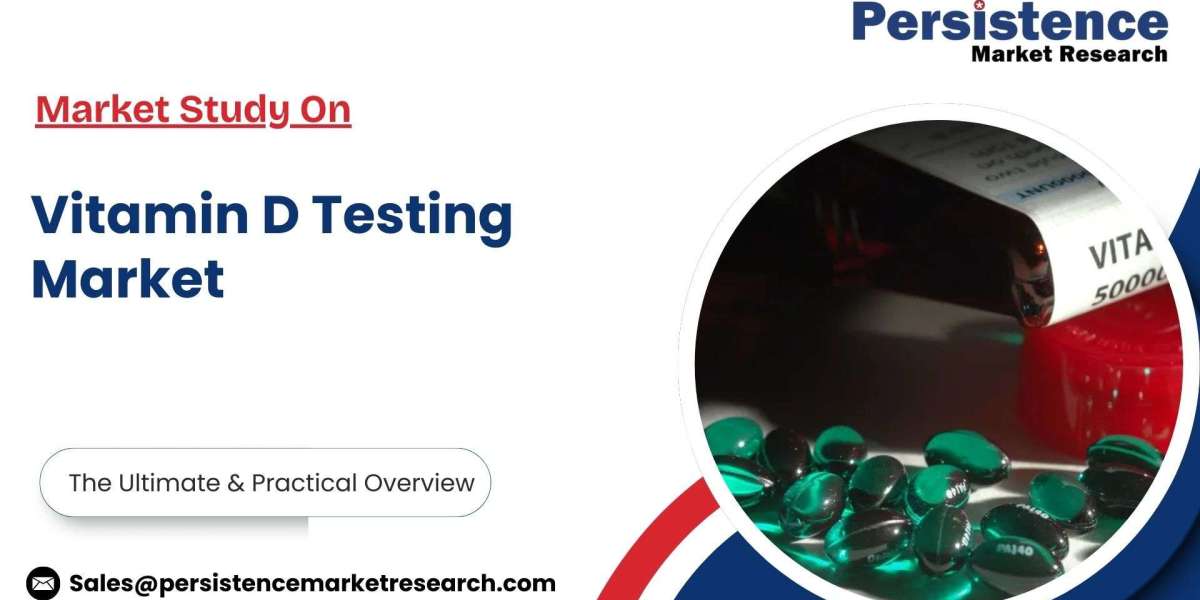The global vitamin D testing market is set for remarkable growth, projected to expand from an estimated US$1.0 billion in 2024 to US$2.0 billion by 2031, securing a compound annual growth rate (CAGR) of 8.1%. The market, which has already seen steady expansion over the past decade, is positioned to accelerate further as digital health technologies, increased awareness of deficiency-related conditions, and a surge in consumer-driven home testing converge to reshape preventive healthcare.
The vitamin D testing market includes a range of diagnostic procedures that measure blood levels of vitamin D, primarily the biomarkers 25-Hydroxy Vitamin D (25(OH)D) and 1,25-dihydroxy Vitamin D (1,25(OH)2D). These tests are essential for detecting deficiencies and managing associated conditions such as osteoporosis, cardiovascular disease, diabetes, autoimmune disorders, and certain cancers. As research increasingly highlights vitamin D’s far-reaching role in bone health, immune function, and chronic disease prevention, the demand for reliable and accessible testing continues to climb.
Historical Performance and Path Forward
Between 2018 and 2023, the vitamin D testing market grew at a CAGR of 6.9%, propelled by rising awareness among at-risk populations including the elderly, patients with chronic illnesses, and those with limited sun exposure. Historically, testing was concentrated within clinical settings and targeted toward individuals already exhibiting symptoms or risk factors. However, broader public recognition of vitamin D’s importance, coupled with technological advancements, has expanded the market’s reach to include proactive and health-conscious consumers.
Recent innovations in automated immunoassays, high-performance liquid chromatography (HPLC), and point-of-care testing have simplified workflows for laboratories while improving accuracy and turnaround times. At the same time, home testing kits have emerged as a popular alternative for consumers seeking convenience, privacy, and integration with telehealth services. These developments point toward a more decentralized, consumer-driven model of vitamin D monitoring.
Digital Health Integration Driving Market Trends
One of the most transformative developments shaping the vitamin D testing landscape is the integration of diagnostic services with digital health platforms and mobile applications. Consumers can now order at-home test kits, collect samples independently, and ship them to laboratories for analysis. Results are uploaded directly to apps, where users can monitor trends over time and receive personalized health recommendations.
These platforms often utilize artificial intelligence to analyze data and provide tailored lifestyle or supplementation advice. By combining test results with information on diet, exercise, and sun exposure, digital health solutions are creating a holistic and personalized approach to managing vitamin D levels. The convenience of at-home testing, paired with real-time tracking and AI-driven recommendations, reflects a broader shift toward preventive and personalized medicine.
Key Growth Drivers
Rising awareness of vitamin D deficiency remains the central driver of demand. Deficiency has been linked to a range of conditions including osteoporosis, cardiovascular diseases, and metabolic disorders. Governments and health organizations have launched campaigns emphasizing the role of vitamin D in public health, while physicians increasingly recommend routine screening.
The growing prevalence of chronic diseases further underscores the need for vitamin D testing. Osteoporosis, which weakens bones and increases fracture risk, is strongly associated with inadequate vitamin D levels. Cardiovascular conditions, such as hypertension and coronary artery disease, have also been tied to deficiency through mechanisms involving vascular function and inflammation. As global populations age and lifestyles become more sedentary, proactive monitoring of vitamin D status is becoming an essential component of disease prevention.
Technological innovation is another critical driver. Automated systems allow laboratories to process high volumes of samples efficiently, while point-of-care devices provide rapid results in outpatient and community settings. These innovations align with the healthcare industry’s focus on preventive care, making testing more accessible to both providers and patients.
Challenges and Market Restraints
Despite robust growth prospects, the market faces hurdles. Interpreting vitamin D test results is often complicated by variables such as seasonal sunlight exposure, geographic location, skin pigmentation, age, and genetic differences. For example, individuals living in northern latitudes may exhibit deficiencies during winter months, while urban dwellers exposed to pollution may also show lower levels. These variations necessitate personalized interpretation, creating challenges for standardized diagnosis and treatment.
The emergence of alternative testing methods, such as wearable devices that track UV exposure or non-invasive saliva and urine tests, presents both opportunities and risks. While these approaches expand accessibility, they may reduce reliance on traditional blood-based testing, potentially reshaping competitive dynamics in the market.
Opportunities Ahead
Opportunities abound as research continues to reveal the implications of vitamin D in a wide range of conditions beyond skeletal health. Associations with autoimmune disorders, cancers, and mental health conditions are expanding the clinical importance of vitamin D monitoring. This creates potential for testing to become a standard component of preventive health assessments globally.
The consumer-driven surge in home testing kits is another area of significant opportunity. As patients increasingly seek tools that enable self-monitoring, companies that can integrate home kits with telehealth consultations and personalized health recommendations are likely to capture substantial market share. Demand for these services has been amplified by the pandemic-era shift toward remote healthcare and a greater emphasis on individual wellness management.
Category Analysis
Among product categories, 25-Hydroxy Vitamin D (25(OH)D) testing remains dominant, accounting for the largest share of the market. This biomarker serves as the gold standard for assessing vitamin D status, reflecting both dietary intake and endogenous production. With advancements in mass spectrometry and chromatography improving accuracy, the demand for this test is expected to maintain momentum, growing at a projected CAGR of 6.9% through 2031.
By application, osteoporosis management represents the most significant driver of demand, projected to grow at 7.1% CAGR. Routine vitamin D testing is increasingly integrated into osteoporosis prevention and treatment protocols, underscoring its role in maintaining bone density and reducing fracture risks.
Regional Outlook
North America currently leads the vitamin D testing market, supported by widespread awareness, high prevalence of deficiency, and advanced healthcare infrastructure. The region’s aging population, particularly in the United States and Canada, amplifies demand, while public health campaigns and professional guidelines encourage regular screening. North America’s market is forecast to grow at 7.4% CAGR through 2031.
East Asia, meanwhile, is expected to record notable growth at 8.0% CAGR. Rapid urbanization in countries like China, Japan, and South Korea has reduced outdoor activity, contributing to higher deficiency rates. Expanding healthcare infrastructure, government initiatives promoting preventive care, and rising disposable incomes are also fueling demand. The growing middle class and increased awareness of health risks have made regular diagnostic testing, including vitamin D, more common across the region.
Competitive Landscape
The vitamin D testing market is highly competitive, with key players including Abbott, F. Hoffmann-La Roche Ltd, BIOMÉRIEUX, Thermo Fisher Scientific Inc., Danaher, Siemens Healthineers AG, DiaSorin S.p.A., Beckman Coulter (BD), Tosoh Bioscience, and Quest Diagnostics.
These companies are investing heavily in research and development to enhance accuracy, reduce costs, and integrate testing with digital platforms. Collaborations, partnerships, and acquisitions remain central strategies, allowing firms to expand their geographic reach and diversify product offerings. Innovation in interference blockers and novel testing methods is also a priority to maintain competitive advantage.
Recent Developments and Outlook
Recent surveys underscore the urgency of tackling deficiency: a University of Texas poll in 2021 revealed that over 42% of people suffer from vitamin D insufficiency. As awareness spreads and healthcare systems pivot toward prevention, the demand for efficient, accurate, and consumer-friendly testing solutions is expected to intensify.
With its projected doubling in value by 2031, the vitamin D testing market sits at the intersection of diagnostic innovation, digital health, and consumer empowerment. As companies race to capitalize on growing demand, the market is set to play a pivotal role in reshaping preventive healthcare and personalized medicine in the decade ahead.
Read Related Reports:














